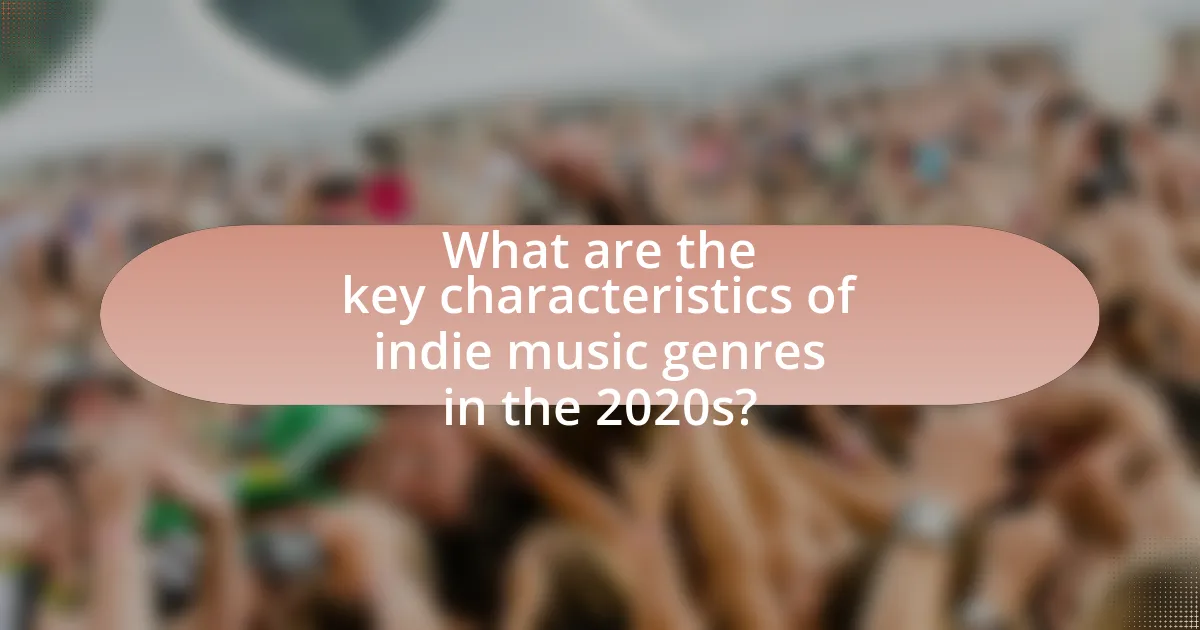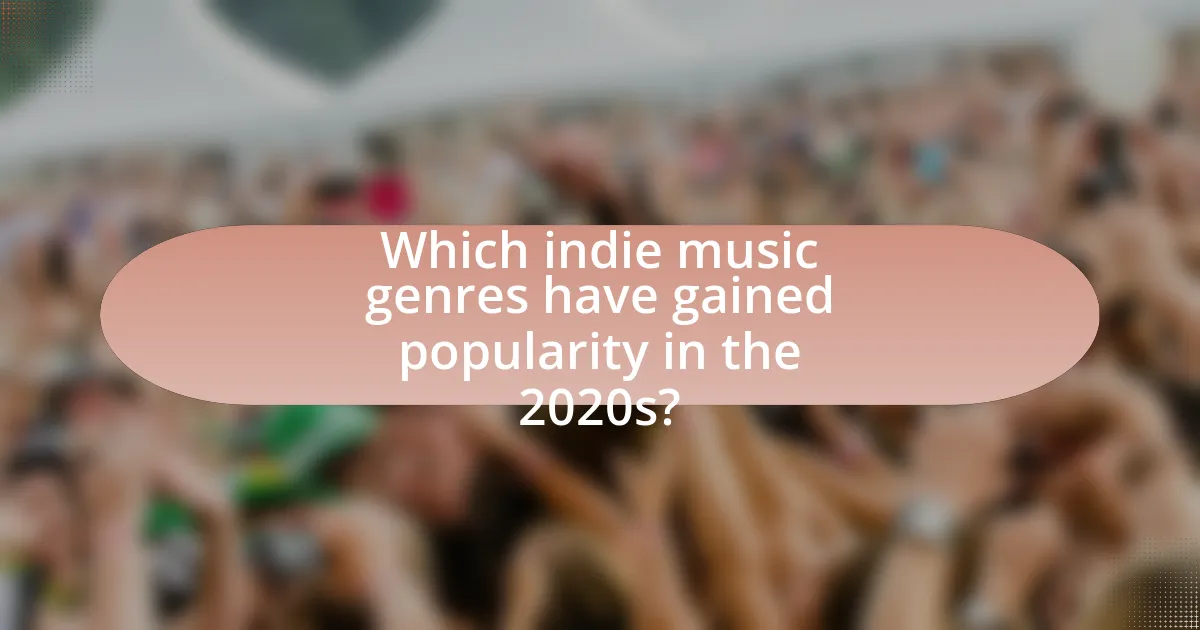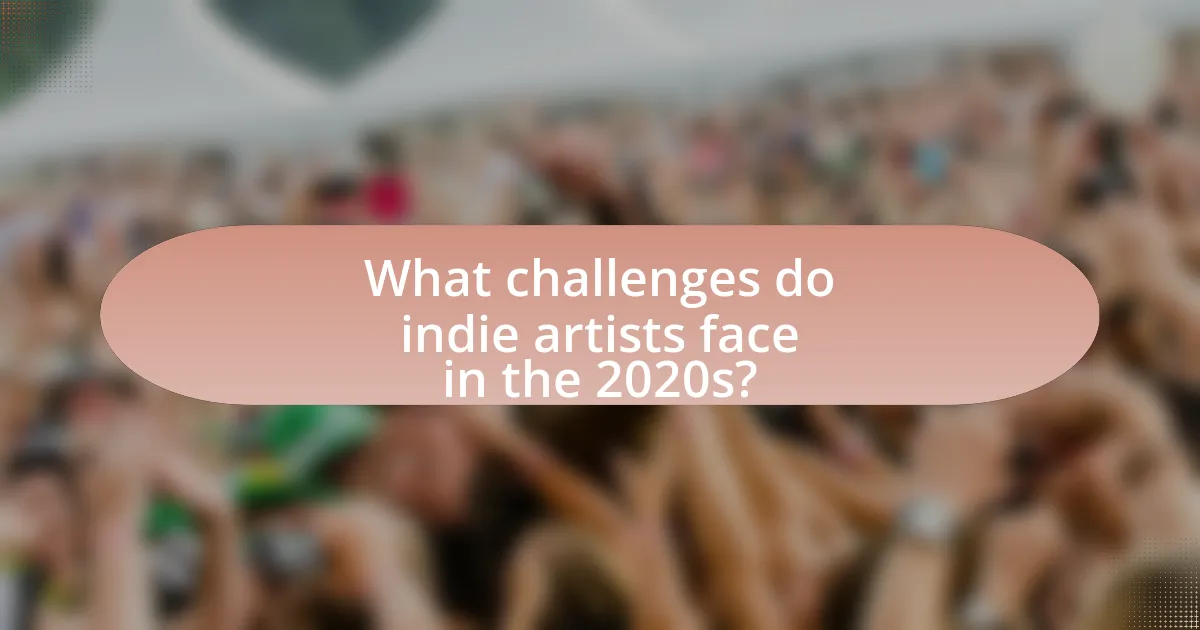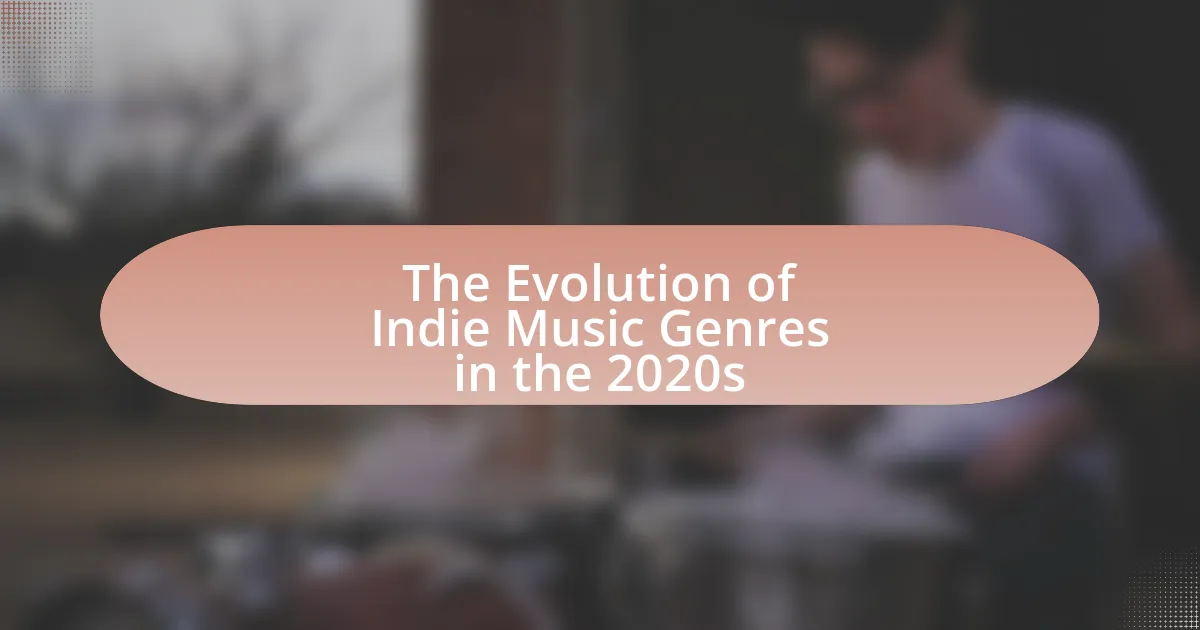The article examines the evolution of indie music genres in the 2020s, highlighting key characteristics such as genre fusion, DIY production, and a focus on authenticity. It discusses how technological advancements and social media have transformed music distribution and promotion, enabling independent artists to reach wider audiences. The piece also explores the challenges faced by indie musicians, including market saturation and financial constraints, while identifying emerging sub-genres like bedroom pop and indie folk. Notable artists and collaborations that have shaped the current landscape are also addressed, providing insight into the dynamic nature of indie music today.

What are the key characteristics of indie music genres in the 2020s?
Indie music genres in the 2020s are characterized by a blend of diverse influences, DIY production techniques, and a focus on authenticity. Artists often incorporate elements from various genres such as pop, rock, electronic, and hip-hop, resulting in a fusion that reflects personal and cultural narratives. The rise of digital platforms has enabled independent musicians to produce and distribute their work without major label constraints, fostering a more experimental and eclectic sound. Additionally, themes of social justice, mental health, and identity are prevalent in lyrics, resonating with contemporary audiences. This evolution is supported by data showing that independent artists accounted for over 40% of global music consumption in 2021, highlighting the significant impact of indie music in the current landscape.
How have indie music genres evolved in the 2020s?
Indie music genres have evolved in the 2020s by increasingly blending with mainstream pop and electronic elements, resulting in a more diverse sound palette. This evolution is evidenced by the rise of artists like Phoebe Bridgers and Clairo, who incorporate pop production techniques into their indie roots, making their music more accessible to wider audiences. Additionally, the use of social media platforms like TikTok has accelerated the popularity of indie tracks, allowing for viral moments that propel lesser-known artists into the mainstream. The genre has also seen a significant increase in collaborations across different styles, further blurring the lines between indie and other genres, as seen in the works of artists like Sufjan Stevens and Angelo De Augustine.
What influences have shaped the sound of indie music in this decade?
The sound of indie music in this decade has been shaped by a blend of technological advancements, genre fusion, and cultural movements. Technological advancements, particularly the rise of digital production tools and streaming platforms, have democratized music creation and distribution, allowing a wider range of artists to experiment with sound. Genre fusion has become prominent, with indie artists incorporating elements from pop, electronic, and hip-hop, leading to innovative soundscapes. Additionally, cultural movements, such as the emphasis on social justice and mental health awareness, have influenced lyrical themes and artistic expression within the indie music scene. These factors collectively contribute to the evolving landscape of indie music in the 2020s.
How do production techniques differ from previous decades?
Production techniques in the 2020s differ significantly from previous decades due to advancements in technology and accessibility of digital tools. Modern producers utilize software like Ableton Live and Logic Pro, which allow for intricate layering and manipulation of sounds that were not possible with analog equipment used in earlier decades. Additionally, the rise of home studios has democratized music production, enabling independent artists to create high-quality recordings without the need for expensive studio time, a stark contrast to the reliance on professional studios in the past. This shift has led to a more diverse range of sounds and styles in indie music, as artists experiment with various genres and production methods, reflecting the broader cultural and technological changes of the era.
What role do technology and social media play in the evolution of indie music?
Technology and social media are pivotal in the evolution of indie music by enabling artists to distribute their work independently and connect directly with audiences. Digital platforms like Bandcamp, SoundCloud, and Spotify allow musicians to release music without traditional label constraints, fostering a diverse range of sounds and styles. Social media platforms such as Instagram, TikTok, and Twitter facilitate real-time engagement, allowing artists to build fanbases and promote their music effectively. For instance, TikTok has propelled numerous indie songs to viral status, demonstrating how social media can significantly impact music discovery and popularity. This shift has democratized the music industry, allowing for greater representation and innovation within the indie genre.
How has streaming changed the landscape for indie artists?
Streaming has significantly transformed the landscape for indie artists by providing them with unprecedented access to global audiences. This shift allows indie musicians to distribute their music widely without the need for traditional record labels, which often impose restrictive contracts. According to a 2021 report by the International Federation of the Phonographic Industry (IFPI), independent artists accounted for 43% of global music consumption, highlighting the growing influence of streaming platforms like Spotify and Apple Music. These platforms enable artists to reach listeners directly, facilitating a more democratic music industry where talent can thrive based on merit rather than marketing budgets.
What impact does social media have on indie music promotion?
Social media significantly enhances indie music promotion by providing artists with direct access to a global audience. Platforms like Instagram, Twitter, and TikTok allow indie musicians to share their music, engage with fans, and build a community without the need for traditional record labels. According to a 2021 report by the International Federation of the Phonographic Industry, 70% of music consumers discover new music through social media platforms, highlighting their crucial role in music promotion. Additionally, social media enables targeted advertising, allowing indie artists to reach specific demographics effectively, which can lead to increased streaming and concert attendance.

Which indie music genres have gained popularity in the 2020s?
Indie pop and bedroom pop are the indie music genres that have gained significant popularity in the 2020s. The rise of platforms like TikTok has propelled artists in these genres to mainstream success, with songs often going viral and leading to increased streaming numbers. For instance, artists like Clairo and Phoebe Bridgers have seen their music reach wider audiences, reflecting a shift towards more personal and intimate songwriting styles that resonate with younger listeners. Additionally, the incorporation of lo-fi production techniques and DIY aesthetics has further defined the sound of indie pop and bedroom pop in this decade.
What are the emerging sub-genres within indie music?
Emerging sub-genres within indie music include bedroom pop, indie folk, and synth-pop. Bedroom pop has gained traction due to its lo-fi production and personal lyrics, often created by artists in home studios, exemplified by musicians like Clairo and Rex Orange County. Indie folk has evolved with a focus on acoustic instrumentation and storytelling, with artists such as Phoebe Bridgers and Sufjan Stevens leading the way. Synth-pop, characterized by its use of synthesizers and electronic elements, has seen a resurgence with acts like CHVRCHES and MUNA, blending catchy melodies with indie sensibilities. These sub-genres reflect the diverse influences and innovative approaches within the indie music scene in the 2020s.
How do these sub-genres reflect current cultural trends?
Sub-genres of indie music in the 2020s reflect current cultural trends by addressing themes of identity, social justice, and mental health. For instance, the rise of bedroom pop showcases the influence of digital accessibility and personal storytelling, resonating with a generation that values authenticity and vulnerability. Additionally, genres like indie folk and lo-fi hip-hop incorporate elements of nostalgia and introspection, mirroring societal shifts towards mindfulness and emotional awareness. This alignment with contemporary issues is evidenced by the increasing popularity of artists who openly discuss their struggles and experiences, such as Clairo and Phoebe Bridgers, who have garnered significant attention for their relatable lyrics and personal narratives.
What are some notable artists leading these sub-genres?
Notable artists leading sub-genres of indie music in the 2020s include Phoebe Bridgers in indie rock, Yves Tumor in experimental pop, and Snail Mail in indie pop. Phoebe Bridgers gained recognition for her introspective lyrics and unique sound, exemplified by her album “Punisher,” which received critical acclaim and multiple Grammy nominations. Yves Tumor has pushed boundaries within experimental pop, blending genres and creating a distinct auditory experience, particularly noted in their album “Heaven to a Tortured Mind.” Snail Mail, led by Lindsey Jordan, has been influential in the indie pop scene with their debut album “Lush,” which showcased a fresh take on personal storytelling in music.
How do collaborations influence the evolution of indie music genres?
Collaborations significantly influence the evolution of indie music genres by blending diverse musical styles and expanding creative boundaries. This fusion allows artists to experiment with new sounds, leading to the emergence of sub-genres and innovative approaches within the indie music scene. For instance, collaborations between indie artists and mainstream producers have resulted in the incorporation of electronic elements into traditional indie rock, as seen in the works of artists like Bon Iver and James Blake. Such partnerships not only enhance the sonic palette but also increase visibility and accessibility for indie music, as collaborative projects often attract a wider audience. This trend is supported by data showing that collaborative tracks frequently achieve higher streaming numbers and chart placements, indicating their impact on the genre’s evolution.
What are some significant collaborations in the 2020s indie scene?
Significant collaborations in the 2020s indie scene include the partnership between Phoebe Bridgers and Conor Oberst, which resulted in the album “Better Oblivion Community Center” in 2019, and the collaboration between Sufjan Stevens and Angelo De Augustine on the album “A Beginner’s Mind” in 2021. These collaborations have garnered critical acclaim, with “Better Oblivion Community Center” receiving a score of 85 on Metacritic, indicating universal acclaim, and “A Beginner’s Mind” praised for its introspective lyrics and harmonious sound. Additionally, the collaboration between indie pop artist Mitski and producer Dan Nigro on her album “Laurel Hell” in 2022 further exemplifies the innovative partnerships shaping the indie music landscape in this decade.
How do collaborations impact genre blending in indie music?
Collaborations significantly enhance genre blending in indie music by merging diverse musical styles and influences. When artists from different genres collaborate, they create innovative sounds that challenge traditional genre boundaries, leading to the emergence of hybrid genres. For instance, the collaboration between indie rock bands and electronic artists has resulted in subgenres like synth-pop and chillwave, which combine live instrumentation with electronic production techniques. This trend is supported by data from the 2021 Spotify Wrapped report, which indicated a 30% increase in genre-blending playlists, showcasing listener demand for diverse musical experiences. Thus, collaborations serve as a catalyst for genre evolution in the indie music scene.

What challenges do indie artists face in the 2020s?
Indie artists in the 2020s face significant challenges, including market saturation, limited financial resources, and difficulties in gaining visibility. The rise of digital platforms has led to an overwhelming number of artists competing for attention, making it harder for individual indie musicians to stand out. According to a 2021 report by MIDiA Research, over 60% of independent artists struggle to monetize their music effectively due to the low payout rates from streaming services. Additionally, many indie artists lack access to marketing and promotional resources, which further hampers their ability to reach wider audiences. These factors collectively create a challenging environment for indie artists trying to establish and sustain their careers in the current music landscape.
How do financial constraints affect indie music production?
Financial constraints significantly limit indie music production by restricting access to quality recording equipment, professional studios, and marketing resources. Indie artists often rely on low-budget home studios or DIY methods, which can compromise sound quality and production value. According to a 2021 survey by the Music Industry Research Association, 70% of indie musicians reported that financial limitations hindered their ability to produce high-quality recordings. Additionally, without sufficient funds for promotion, many indie artists struggle to reach wider audiences, impacting their overall success and sustainability in the competitive music industry.
What are the common funding sources for indie artists today?
Common funding sources for indie artists today include crowdfunding platforms, grants, music licensing, merchandise sales, and direct fan support through subscription services. Crowdfunding platforms like Kickstarter and Indiegogo allow artists to raise funds directly from fans, often in exchange for exclusive content or rewards. Grants from arts organizations and government bodies provide financial support for creative projects, while music licensing opportunities enable artists to earn revenue by allowing their music to be used in films, commercials, and video games. Additionally, merchandise sales contribute to income, and platforms like Patreon facilitate ongoing financial support from dedicated fans. These funding avenues have become essential for indie artists navigating the evolving music landscape in the 2020s.
How do these financial challenges influence artistic choices?
Financial challenges significantly influence artistic choices by limiting resources available for production, promotion, and distribution. Indie musicians often face budget constraints that compel them to prioritize certain aspects of their work, such as focusing on DIY recording techniques or opting for simpler arrangements to reduce costs. For instance, a study by the University of Southern California found that 70% of independent artists reported financial limitations as a primary factor in their creative decisions, leading to a rise in lo-fi aesthetics and home studio recordings. This economic pressure can also drive artists to explore innovative marketing strategies, such as leveraging social media platforms for direct engagement with audiences, thereby reshaping their artistic identity and outreach methods.
What barriers exist for indie artists in gaining mainstream recognition?
Indie artists face several barriers in gaining mainstream recognition, primarily due to limited access to resources, marketing challenges, and industry gatekeeping. Limited financial resources restrict indie artists from investing in professional production, marketing, and distribution, which are crucial for reaching wider audiences. Additionally, marketing challenges arise from the saturation of the music market, making it difficult for indie artists to stand out without substantial promotional budgets. Industry gatekeeping, where major labels and media outlets prioritize established artists, further hinders indie artists’ visibility and opportunities for exposure. According to a 2021 report by the Music Industry Research Association, 70% of indie artists reported difficulties in securing radio play and media coverage, underscoring the systemic barriers they encounter in the pursuit of mainstream success.
How does the music industry structure impact indie artists?
The music industry structure significantly impacts indie artists by limiting their access to mainstream distribution channels and marketing resources. Indie artists often rely on alternative platforms such as Bandcamp and SoundCloud, which provide them with opportunities to reach audiences without the backing of major labels. According to a 2021 report by the International Federation of the Phonographic Industry, independent labels accounted for 40% of global recorded music revenue, indicating a growing market presence despite structural challenges. This shift allows indie artists to cultivate niche audiences and maintain creative control, but it also means they face increased competition and must invest more in self-promotion and digital marketing strategies to succeed.
What strategies can indie artists use to overcome these barriers?
Indie artists can overcome barriers by leveraging digital platforms for distribution and promotion. Utilizing social media channels like Instagram and TikTok allows artists to reach wider audiences without significant financial investment. According to a 2021 report by the International Federation of the Phonographic Industry, 70% of music consumers discover new artists through social media, highlighting its effectiveness. Additionally, indie artists can collaborate with other musicians and creators to expand their networks and share resources, which fosters community support and enhances visibility. Engaging in live streaming performances and virtual events can also create direct connections with fans, further solidifying their presence in the competitive music landscape.
What are the best practices for indie artists in the 2020s?
The best practices for indie artists in the 2020s include leveraging digital platforms for distribution, engaging with audiences through social media, and focusing on building a personal brand. Digital platforms like Spotify and Bandcamp allow artists to reach global audiences without traditional gatekeepers, as evidenced by the rise of independent artists topping charts. Engaging with fans on social media fosters community and loyalty, which is crucial for sustaining a career; studies show that artists who actively interact with their followers see increased streaming and sales. Additionally, a strong personal brand helps indie artists differentiate themselves in a crowded market, as demonstrated by successful campaigns from artists like Billie Eilish, who effectively utilized her unique aesthetic and narrative to connect with listeners.
How can indie artists effectively market their music today?
Indie artists can effectively market their music today by leveraging social media platforms, engaging with their audience, and utilizing digital distribution services. Social media allows artists to build a direct connection with fans, share content, and promote new releases, which is crucial as 79% of consumers say user-generated content highly impacts their purchasing decisions. Engaging with fans through live streams, Q&A sessions, and personalized messages fosters a loyal community. Additionally, digital distribution services like DistroKid and TuneCore enable artists to reach global audiences by making their music available on major streaming platforms, which is essential since over 60% of music consumption now occurs through streaming.
What role does community engagement play in an indie artist’s success?
Community engagement is crucial for an indie artist’s success as it fosters a loyal fan base and enhances visibility. By actively participating in local events, social media interactions, and collaborations with other artists, indie musicians can create meaningful connections with their audience. This engagement leads to increased word-of-mouth promotion, which is vital in the indie music scene where traditional marketing resources may be limited. Research indicates that artists who engage with their communities often see higher attendance at shows and increased sales of music and merchandise, demonstrating the tangible benefits of building these relationships.

